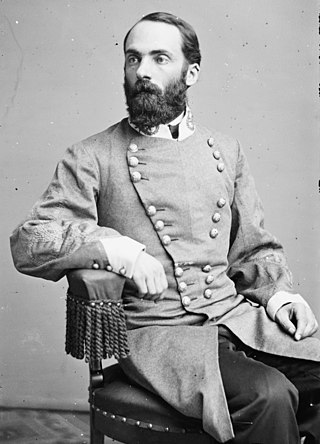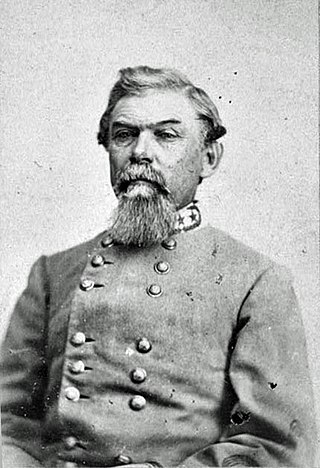Service history
General Sherman, a 187-ton side-wheel "tinclad" river gunboat, [1] was one of four light wooden gunboats built at Chattanooga, Tennessee, for the War Department in 1864. She commissioned at Bridgeport, Alabama, 27 July 1864, Acting Master Joseph W. Morehead in command. Turned over to the Navy and commissioned in July 1864, General Sherman spent most of her service on the Upper Tennessee River. General Sherman was assigned to the 11th District, Mississippi Squadron, and became part of Lt. Moreau Forrest's gunboat fleet on the upper Tennessee River.
Leaving Bridgeport, Alabama, 22 August, she patrolled with other gunboats between Decatur, Alabama, and Muscle Shoals, Alabama, controlling guerrilla attacks and working to prevent major elements of Confederate General John Bell Hood's army from crossing the river into Tennessee. General Sherman continued to patrol until she returned to Bridgeport for repairs 17 December. Returning to the upper Tennessee River, General Sherman lent vital artillery support to the forces of Gen. James B. Steedman at Decatur, 27 December, shelling Confederate emplacements as Union Army troops crossed the river. She again patrolled the river, attempting to cut off the withdrawal of Hood's army from Tennessee and convoying Union supply ships, until the war ended. General Sherman was returned to the Army Quartermaster Department at Chattanooga, Tennessee, 3 June 1865

Joseph "Fighting Joe" Wheeler was a military commander and politician of the Confederate States of America. He was a cavalry general in the Confederate States Army in the 1860s during the American Civil War, and then a general in the United States Army during both the Spanish-American and Philippine–American Wars near the turn of the twentieth century. For much of the Civil War, he was the senior cavalry general in the Army of Tennessee and fought in most of its battles in the Western Theater.

The Battle of Atlanta took place during the Atlanta Campaign of the American Civil War on July 22, 1864, just southeast of Atlanta, Georgia. Continuing their summer campaign to seize the important rail and supply hub of Atlanta, Union forces commanded by William Tecumseh Sherman overwhelmed and defeated Confederate forces defending the city under John Bell Hood. Union Major General James B. McPherson was killed during the battle, the second-highest-ranking Union officer killed in action during the war. Despite the implication of finality in its name, the battle occurred midway through the Atlanta campaign, and the city did not fall until September 2, 1864, after a Union siege and various attempts to seize railroads and supply lines leading to Atlanta. After taking the city, Sherman's troops headed south-southeastward toward Milledgeville, the state capital, and on to Savannah with the March to the Sea.

William Joseph Hardee was a career U.S. Army and Confederate States Army officer. For the U.S. Army, he served in the Second Seminole War and in the Mexican–American War, where he was captured and exchanged. In the American Civil War, he sided with the South and became a general. Hardee served in the Western Theater and quarreled sharply with two of his commanding officers, Braxton Bragg and John Bell Hood. He served in the Atlanta Campaign of 1864 and the Carolinas Campaign of 1865, where he surrendered to General Joseph E. Johnston to William Tecumseh Sherman in April. Hardee's writings about military tactics were widely used on both sides in the conflict.

The Battle of Nashville was a two-day battle in the Franklin-Nashville Campaign that represented the end of large-scale fighting west of the coastal states in the American Civil War. It was fought at Nashville, Tennessee, on December 15–16, 1864, between the Confederate Army of Tennessee under Lieutenant General John Bell Hood and the Union Army of the Cumberland (AoC) under Major General George H. Thomas. In one of the largest victories achieved by the Union Army during the war, Thomas attacked and routed Hood's army, largely destroying it as an effective fighting force.

The Atlanta campaign was a series of battles fought in the Western Theater of the American Civil War throughout northwest Georgia and the area around Atlanta during the summer of 1864. Union Maj. Gen. William Tecumseh Sherman invaded Georgia from the vicinity of Chattanooga, Tennessee, beginning in May 1864, opposed by the Confederate general Joseph E. Johnston.

The Army of the Cumberland was one of the principal Union armies in the Western Theater during the American Civil War. It was originally known as the Army of the Ohio.

The third USS Lexington was a timberclad gunboat in the United States Navy during the American Civil War.
The Battle of Decatur was a demonstration conducted from October 26 to October 29, 1864, as part of the Franklin-Nashville Campaign of the American Civil War. Union forces of 3–5,000 men under Brigadier-General Robert S. Granger prevented the 39,000 men of the Confederate Army of Tennessee under General John B. Hood from crossing the Tennessee River at Decatur, Alabama.
The Battle of Johnsonville was fought November 4–5, 1864, in Benton and Humphreys counties, Tennessee, during the American Civil War. Confederate cavalry commander Major General Nathan Bedford Forrest culminated a 23-day raid through western Tennessee by attacking the Union supply base at Johnsonville. Forrest's attack destroyed a total of 28 Union boats and barges in the Tennessee River and millions of dollars of supplies, disrupting the logistical operations of Union Major General George H. Thomas in Nashville. As a result, Thomas's army was hampered in its plan to defeat Confederate Lieutenant General John Bell Hood's invasion of Tennessee, known as the Franklin–Nashville campaign.

The Franklin–Nashville campaign, also known as Hood's Tennessee campaign, was a series of battles in the Western Theater, conducted from September 18 to December 27, 1864, in Alabama, Tennessee, and northwestern Georgia during the American Civil War.

The western theater of the American Civil War encompassed major military operations in the states of Alabama, Georgia, Florida, Mississippi, North Carolina, Kentucky, South Carolina and Tennessee, as well as Louisiana east of the Mississippi River. Operations on the coasts of these states, except for Mobile Bay, are considered part of the Lower Seaboard Theater. Most other operations east of the Appalachian Mountains are part of the eastern theater. Operations west of the Mississippi River took place in the trans-Mississippi theater.

The city of Atlanta, Georgia, in Fulton County, was an important rail and commercial center during the American Civil War. Although relatively small in population, the city became a critical point of contention during the Atlanta Campaign in 1864 when a powerful Union Army approached from Union-held Tennessee. The fall of Atlanta was a critical point in the Civil War, giving the North more confidence, and leading to the re-election of President Abraham Lincoln and the eventual dissolution of the Confederacy. The capture of the "Gate City of the South" was especially important for Lincoln as he was in a contentious election campaign against the Democratic opponent George B. McClellan.

USS St. Clair was a steamer purchased by the Union Navy during the American Civil War.
USS Reindeer was a steamer purchased by the Union Navy during the American Civil War.
USS Hastings was a steamer purchased by the Union Navy during the American Civil War. She was used by the Union Navy as a gunboat assigned to patrol Confederate waterways.

USS Eastport was a steamer captured by the Union Navy during the American Civil War. She was used by the Union Navy as a convoy and patrol vessel on Confederate waterways.
USS General Burnside was a steamship acquired by the Union Navy during the American Civil War. She was used by the Union Navy as a gunboat, and was assigned to patrol waterways in the Confederate South. She was named after Union General Ambrose Burnside.

USS General Grant was a steamship chartered from the U.S. War Department by the Union Navy during the American Civil War. She was used by the Navy as a gunboat in waterways of the Confederate South.
USS General Thomas was a Steamship chartered from the U.S. War Department by the Union Navy during the American Civil War. Named after Maj. Gen. George Henry Thomas, she was used by the Navy as a gunboat in waterways of the Confederate South.

Forrest's Cavalry Corps was part of the Confederate States Army during the American Civil War and commanded by Lieutenant General Nathan Bedford Forrest. Formed during the summer of 1862, it took part in the various battles in the Western Theater during the second half of the war. At first serving as part of the Army of Tennessee, both Forrest and the corps were then transferred to northern Mississippi and often launched independent raids into Union occupied western and central Tennessee.














